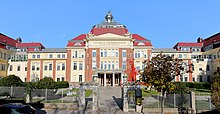Ernst Gotthilf
Ernst Gotthilf (born October 1, 1865 in Temesvár , then Hungary , now Romania , † September 17, 1950 in Oxford , Great Britain ) was an Austrian architect, primarily of the late classicist reform style .
biography
Ernst Gotthilf was born in Temesvár as the son of the large Jewish industrialist Eduard Gotthilf de Miskolcz, who was ennobled in 1885, and Josefine Stern. He began his training as an architect at the Polytechnic in Zurich and then moved to Vienna to the Technical University and the Academy of Fine Arts . After practicing with Helmer and Fellner for two years , he went into business for himself at the age of 27.
His first commissions were mainly rental houses and residential and commercial buildings. The most prominent client in this period was the committee of the Viennese merchants with their hospital on Peter-Jordan-Straße.
In 1909 Ernst Gotthilf and Alexander Neumann (1861–1947) founded an office community that soon became a leader in Vienna. They built rental houses, villas and palaces and also made a name for themselves as planners of bank buildings. They were also able to carry out construction contracts during the First World War . Only after the end of the war and the associated loss of financially strong clients were hardly any more orders.
Ernst Gotthilf emigrated to the connection of Austria to the Third Reich to England , where he settled in Oxford. His wife, daughter of the then well-known Viennese city architect Donat Zahler (1845–1909), also died in England in 1965.
Awards
Ernst Gotthilf has received numerous awards and honorary degrees in the course of his work:
- Golden Füger Medal
- Building Councilor (around 1908)
- Knight's Cross of the Franz Joseph Order (around 1913)
- Sworn expert and appraiser for the regional and commercial court (1914)
- Senior Building Councilor (1918)
- Honorary member of the Central Association of Architects in Austria (1919)
- Professor (1923)
Memberships
- from 1893: Cooperative of the visual artists of Vienna
- from 1893: Austrian Association of Engineers and Architects
- from 1896: Lower Austrian trade association
- from 1907: Central Association of Architects in Austria
- from 1913: founding member of the Austrian Werkbund
Furthermore, Ernst Gotthilf was a member of the central association of architects of the kingdoms and states represented in the Reichsrat - there he also held the office of vice-president - and a member of the architects' club of the cooperative of visual artists Vienna.
Works
In addition to the structures mentioned here, Ernst Gotthilf carried out numerous other orders alone and with his partner Alexander Neumann - especially rental houses as well as residential and commercial buildings.


- 1895: Palais Lanna , Argentinierstrasse 20, Vienna- Wieden
- 1898–1899: New construction of the facade of the Sofiensäle (Marxergasse 17, Vienna- Landstrasse )
- 1900: Grave monument for Ferdinand Groß ( Vienna Central Cemetery )
- 1902: Home for homeless families ( Universumstrasse 62, Vienna- Brigittenau , together with D. Zahler)
- 1903: House of the Viennese merchants ( Schwarzenbergplatz 14, Vienna- Wieden )
- 1904: Foundation house of the committee of the Viennese merchants' association (Krugerstraße 3, Vienna- Inner City )
- 1905: Pharmacy of the Mother of God ( Gudrunstraße 150, Vienna- Favoriten )
- 1906: House of Basler Versicherung (Lothringerstraße 16, Vienna-Innere Stadt)
- 1906: Women's department of the Löw Sanatorium , including and adapting the adjacent house (Mariannengasse 18–20, Vienna- Alsergrund )
- 1907-08: Villa Siegfried Trebitsch , Maxingstrasse 20 (construction by Hugo Schuster )
- 1908: Administrator's house of the University of Natural Resources and Life Sciences (Gregor-Mendel-Straße 33, Vienna- Währing )
- 1908–1910: Hospital of the Vienna Merchants' Union (Peter-Jordan-Straße 82, Vienna- Döbling , today: Wilhelm-Exner-Haus of the University of Natural Resources and Life Sciences)
- around 1909: Castle in Kierling (Kierlingerstraße 87, Klosterneuburg )
- 1909–1912: Wiener Bankverein ( Schottengasse 6–8, Vienna-Innere Stadt, together with Alexander Neumann)
- 1912: Home for homeless families (Wiesberggasse 13, Vienna- Ottakring )
- 1912–1914: “ Anker-Hof ” office building ( Hoher Markt 10–11, Vienna Innere Stadt, together with Alexander Neumann)
- 1913–1915: Länderbank ( Am Hof 2, Vienna-Innere Stadt, together with Alexander Neumann)
- 1914–1921: Austrian Creditanstalt for Trade and Commerce (Renngasse 2, Vienna-Innere Stadt, today: Bank Austria Kunstforum )
- 1915: Wiener Bankverein (Hauptplatz 14, Graz ), together with Alexander Neumann
- 1916: Rental house group (Schwarzenbergplatz 7–8, Wien-Landstrasse, together with Alexander Neumann)
- 1917–1918: Palais Fanto (Schwarzenbergplatz 6, Wien-Landstrasse, together with Alexander Neumann , later the seat of the Austrian Spirits Monopoly, now the Arnold Schönberg Center )
- 1922: Office building for the Austrian Creditanstalt for Trade and Commerce (Kaiserfeldgasse 5, Graz)
literature
- Gotthilf-Miskolczy Ernst von. In: Austrian Biographical Lexicon 1815–1950 (ÖBL). Volume 2, Verlag der Österreichischen Akademie der Wissenschaften, Vienna 1959, p. 36.
Individual evidence
- ^ The keystone in the home for homeless families. In: Neue Freie Presse , Morgenblatt, No. 13705/1902, October 19, 1902, p. 12 middle. (Online at ANNO ). .
Web links
- Ernst Gotthilf. In: Architects Lexicon Vienna 1770–1945. Published by the Architekturzentrum Wien . Vienna 2007.
- Ernst Gotthilf in the Vienna History Wiki of the City of Vienna
| personal data | |
|---|---|
| SURNAME | Gotthilf, Ernst |
| ALTERNATIVE NAMES | Gotthilf von Miskolczy, Ernst |
| BRIEF DESCRIPTION | Austrian architect |
| DATE OF BIRTH | October 1, 1865 |
| PLACE OF BIRTH | Timișoara |
| DATE OF DEATH | 17th September 1950 |
| Place of death | Oxford |